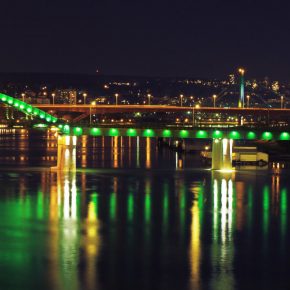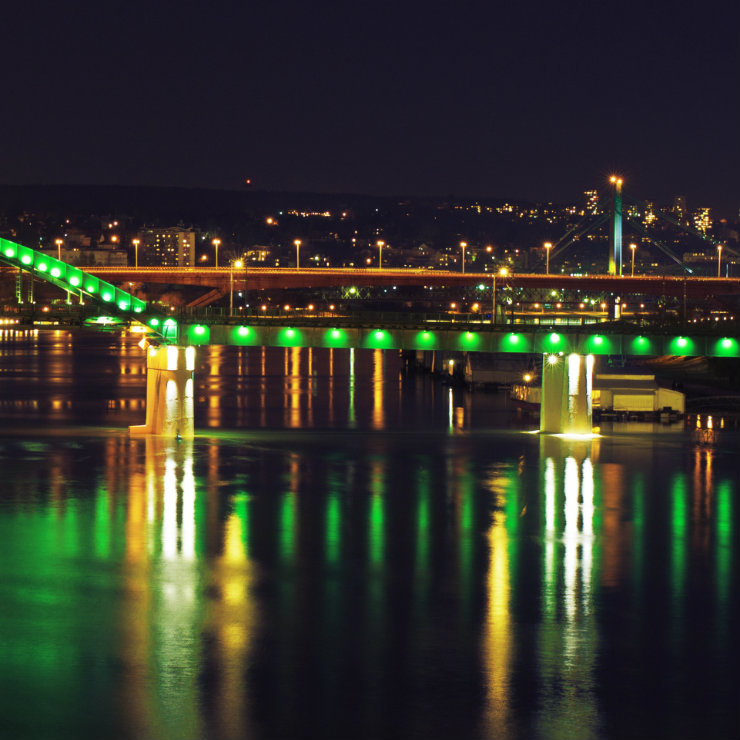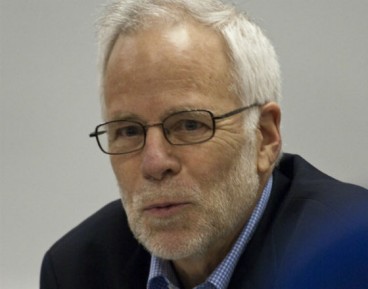Tydzień w gospodarce
Category: Trendy gospodarcze
Analyst in the Balkan Department at the Institute of Central Europe in Lublin, Poland

Belgrade, Serbia (Serzhile, CC BY-ND)
Serbian leaders underline position of their country between the Western Europe and the East. They are aware of the favorable geo-economics location of their country. Through Serbia goes the simplest and the quickest land route from Turkey and Middle East to Europe. Alternative routes follow Bulgaria-Romania-Hungary or Albania-Italy itineraries. Both of them have their blind spots, such as poor infrastructure or necessity of engaging sea transport means.
Serbia is also strategically located in the Balkan Peninsula for other reasons. It has relatively good access to other Southeast European states such as Croatia, Bosnia and Hercegovina, Macedonia or Bulgaria. Serbia has been traditionally connected to the Central European markets through Hungary. Its relative large size (7 million citizens, comparing to 5 million of Croats, or 2 million of Macedonians) is further strengthen by the fact that Serbian minorities constitute significant minority in three other countries (BiH, Montenegro and Kosovo).
The Yugoslav times, however, have been long gone. The New Cold War, as Edward Lucas puts it, has created new economic environment. Southeastern Europe play a role of territory and frontline in this game. Serbia is not a player. This is visible on the general statistics of macroeconomic data. According to Santander portal: the FDI decreased since 2013, when it amounted USD31.5bn, to USD29.5 and 28.8bn in 2015, although the FDI inward flow remained pretty steady oscillating around USD2bn annually.
Poor performance of the Serbian economy is shown by the fact, that despite negative trend in investments the FDI stock as a percentage of GDP is growing, since 69.2 per cent in 2013 to 78.9 per cent in 2015 Therefore, and being unable to gather and stream domestic capital, Serbian authorities are reaching far to bring investors to their country. And they work on the relevant environment too.
We wrote about the Chinese investments in the region (read here). Chinese do not hide the fact that they treat Serbia as a component of the 16+1. Pupinov (or Chinese) bridge in Belgrade, build by the China Roads and Bridges Corporation, importing and employing Chinese workers for the EUR185m credit secured by Chinese Exim Bank (EUR15m has been provided by Serbian and municipal authorities) marked an opening of Serbia to foreign investors at any price.
The same Chinese companies are foreseen to build another bridge in Belgrade for the sum of EUR470m. Last year the Serbian parliament ratified the loan agreement with the Chinese Exim Bank for USD608.26m, which will enable the construction of the third block in Steam Power Plant Kostolac B. This loan will be returned in period of 20 years with the 2.5 per cent of annual interest rate.
Projects in which China invested its own capital are valued over EUR220m. In this regard, according to the Development Agency of Serbia, the two largest Chinese investments in Serbia are „Johnson Electric” (EUR65m) and „Mei Ta” (EUR60m). According to the National Bank of Serbia, for the period from 2007 to 2013, Chinese investments were only slightly higher than the EUR20m. Then in 2014 there was EUR84.4 and topped in 2015 by EUR24m.
Except of the two mentioned above companies the largest Chinese investments were located in textile industry (Everrest Production/HNC LLC with EUR15m and Bestresources International with EUR3.9m, retail (Diplon/Belmax Center with EUR32m); electronics industry (Tesla Solar EUR400,000) and metal industry (He Steel Smederevo with EUR46m). China has a wide range of interests in investing in Serbia and it seems that the dynamics is increasing. Recently, Chinese companies expressed their interest in food industry.
However, agriculture is a sideline of the Chinese investments in Serbia. For several years estates are a subject of FDI. A company from the United Arab Emirates made a lucrative deal with the Government of Serbia and the local authorities by renting some 3,600 hectares of agriculture land in Vojvodina, Northern part of the Republic.
From promised EUR200m of investments in irrigation, infrastructure, and 8 separate agricultural enterprises, Arab partner did not contributed much, complained Olena Papuga, MP representing Vojvodina in Serbian Parliament. Half of the land has not been plowed and employment among local population has not improved as expected.
Russian Federation is among the most important and surely the most highlighted investors in Serbia. Russian investments, however, are far from their actual power. Most infamous deal was the sale of the NIS (Oil Industry of Serbia) well below the market value of the company.
It is a public secret that it was price Serbian government (economy and society) had to pay for non-recognition of an independent Kosovo by Moscow. It did not stop the fact that Kosovo efficiently declared its independence and received recognition from a number of important players, such as Germany, France, United States or Italy.
Gazprom, except of buying the NIS petrol station network, became an owner of the two refineries and a separate gas depot. Gaspromnjeft, similarly to Lukoil, which bought another network of petrol stations – Beopetrol, did not keep the promise of investments and development of the relevant Serbian companies.
In June 2016, Russian President Vladimir Putin declared investment of additional EUR10bn – 8 in infrastructure and 2 in energy sector. How much of these intentions will materialized remains the large question mark.
Still, the largest of the investors are the EU states. FDI from the EU exceeded EUR15bn over the past eleven years, with its peak in 2007, when they constituted over 92 per cent of all investments in Serbia, while during the period of 2013-2015 the relevant number was over 70 per cent. Non-European investments, however, are not conditioned upon the level of democracy, and sometimes irrelevant of the political stability. So they are much easier accessible than capital from Berlin, Amsterdam, Vienna or Paris, where liberal traditions still play an important role. On the other hand, especially in case of Russian economic involvement, inflow of capital is treated as an important factor increasing Russian soft-power and political influence. Chinese companies are not very much interested in the domestic social and economic development, treating Serbia as a basis for further expansion in the region and the continent. Serbian authorities are not content with UAE investment either. So far Belgrade’s invitation did not bring expected fruits.


